This short video (less than one minute) shows you what you need to start silk painting. Hope you’ll enjoy watching!
{find me elsewhere: shop, facebook, etsy, twitter, pinterest}
Custom Wedding Dress & Kimono Upcycled Clothes | オーダーメイドウェディングドレス&着物ドレス
By Chie
By Chie
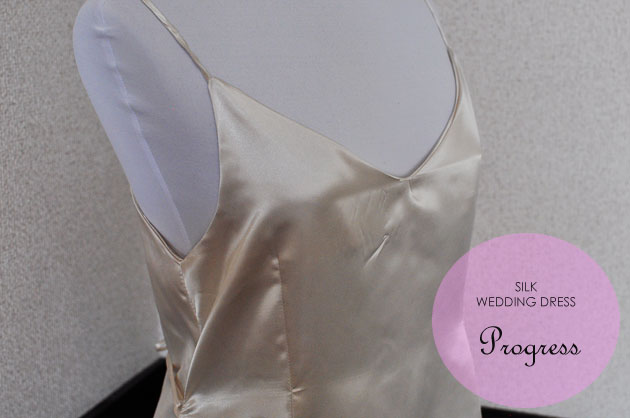 I’ve been working on a silk wedding dress for a bride who is getting married in September. The plan is to make a simple slip dress in silk, and have flower motifs painted in a spiral way from down waist to hem. I’ve been practicing silk painting on cheap polyester as blogged here, and at the same time, making patterns and muslin for the dress. For the muslin, instead of using cotton muslin fabric, I used polyester satin, just because I thought poly satin will be closer to the actual fabric I use for the dress, silk satin. By making the muslin in satin, I was able to see how the dress flows better than a stuff cotton muslin fabric.
I’ve been working on a silk wedding dress for a bride who is getting married in September. The plan is to make a simple slip dress in silk, and have flower motifs painted in a spiral way from down waist to hem. I’ve been practicing silk painting on cheap polyester as blogged here, and at the same time, making patterns and muslin for the dress. For the muslin, instead of using cotton muslin fabric, I used polyester satin, just because I thought poly satin will be closer to the actual fabric I use for the dress, silk satin. By making the muslin in satin, I was able to see how the dress flows better than a stuff cotton muslin fabric.
The dress shape is simple. It has a vertical darts in front and back. The straps are spagetti straps (easy tutorial here). I was easily able to turn the straps inside out since the satin fabric is slippery. To avoid the seams from ripping while turning, I used small stitch (2mm stitch length) and sew the seams twice, which was recommended in one of the tutorials I found in Japanese.
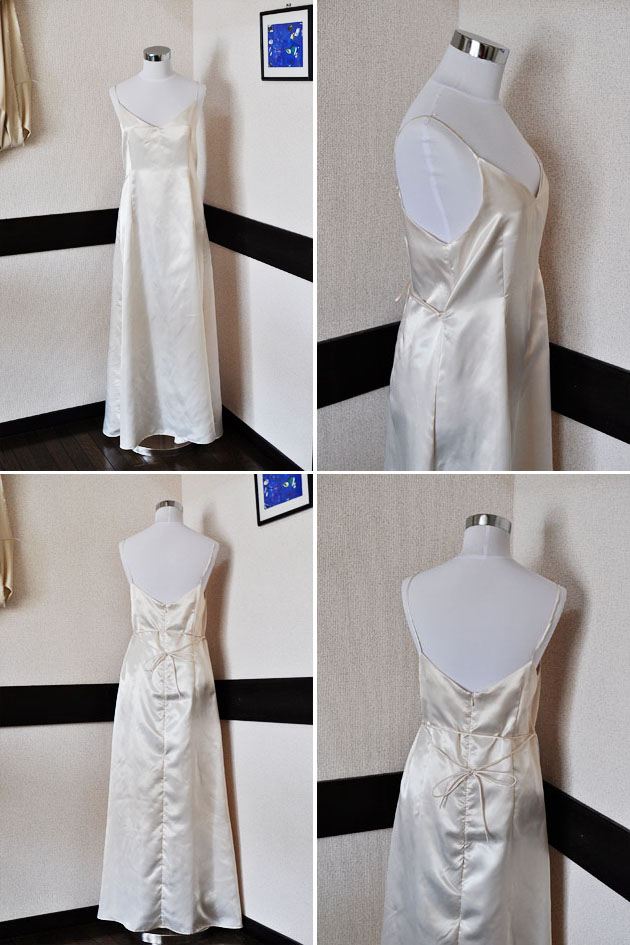
find me elsewhere: shop, facebook, etsy, twitter, pinterest}
By Chie
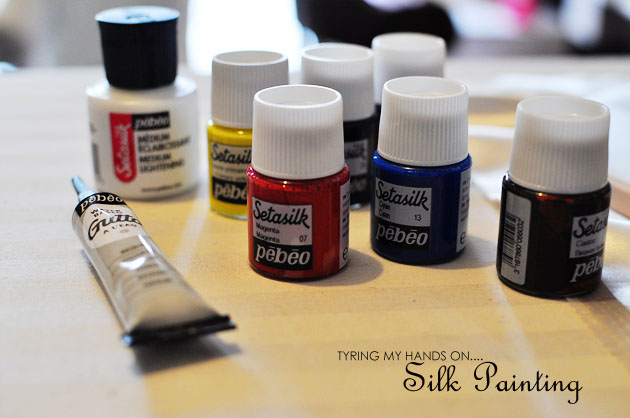 I have new crafting goal, I’m trying – silk painting. It all started when a customer asked for a silk wedding dress with a floral motif. I looked for fabric that is silk and has an asymmetrical floral motif on it, but was unable to find any. However while I searched, I found out about silk painting. I decided to make a dress in white silk and paint a floral motif on it.
I have new crafting goal, I’m trying – silk painting. It all started when a customer asked for a silk wedding dress with a floral motif. I looked for fabric that is silk and has an asymmetrical floral motif on it, but was unable to find any. However while I searched, I found out about silk painting. I decided to make a dress in white silk and paint a floral motif on it.
Silk painting can be done on silk that is stretched on some frame, like an embroidery hoop, using silk painting paints. It started in China, but is more popular in the U.S. and Europe, not so widely seen in Japan. There are a lot of supplies available in U.S. sites, and Dharma Trading is one of them. I was going to buy supplies from Dharma, but the shipping cost was high. So I went on to search Japanese sites that have silk painting supplies available. So far, I only found one: Yume Gazai (ゆめ画材).
There are a few essential materials you need for silk painting: silk paints (I bought SetaSilk, which is a water-based, non-toxic thin paint), Gutta (A resist is a substance that halts the spreading of dye or paint as an outline, or preserves the original color of the fabric in a shape or design), lightening medium (as you can’t use water to thin the color since it may fade), a frame to stretch silk, and brushes. I use an embroidery hoop to stretch silk, and watercolor brushes. As a starter, I bought a clear color gutta. 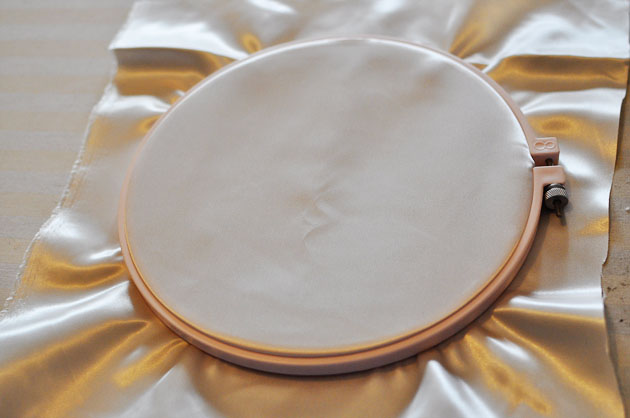
I am going to eventually purchase silk fabric to paint on, but for right now, I wanted to test on cheap fabric. I used off-white color 100% polyester satin. Above is a picture showing how I’m stretching the fabric.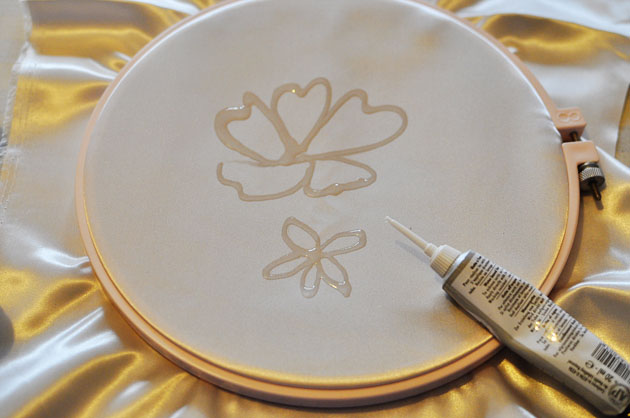 Then, using gutta, I drew the outer shape of the flower motifs. This is to avoid leaking of the silk paint; since the paint is like watercolor and spreads on the fabric canvas so quickly, if you want a clear line, you use gutta to stop it from leaking. It will take me a while to get use to using gutta. The gutta tube does not let me draw a very fine, thin lines. As you can see above, the line is quite thick and it will not work for the project I have in mind. Also, gutta took forever to dry.
Then, using gutta, I drew the outer shape of the flower motifs. This is to avoid leaking of the silk paint; since the paint is like watercolor and spreads on the fabric canvas so quickly, if you want a clear line, you use gutta to stop it from leaking. It will take me a while to get use to using gutta. The gutta tube does not let me draw a very fine, thin lines. As you can see above, the line is quite thick and it will not work for the project I have in mind. Also, gutta took forever to dry. 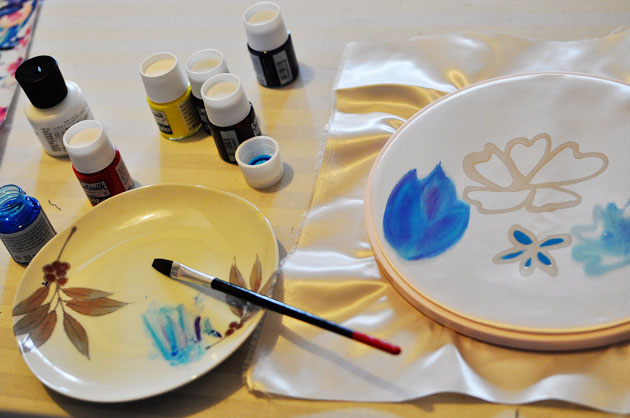
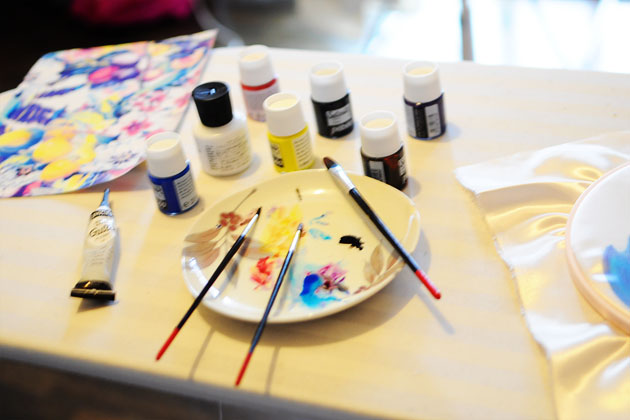
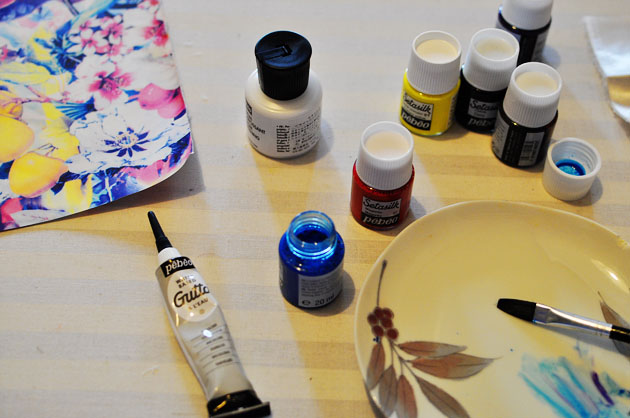 After that, painting is just like drawing with watercolor. You can mix the color and just paint. It will take a bit of practice to figure out how much the paint bleeds.
After that, painting is just like drawing with watercolor. You can mix the color and just paint. It will take a bit of practice to figure out how much the paint bleeds.
After finishing the paint, I let it completely dry for 24 hours and then iron to set the color. I set the iron in low-heat setting and iron the fabric in a circular motion. I hand-washed the fabric in cold water to see if the color fades, but it was ok! Not that I will wash silk fabric, it is good to know that the color is intact even after washing. 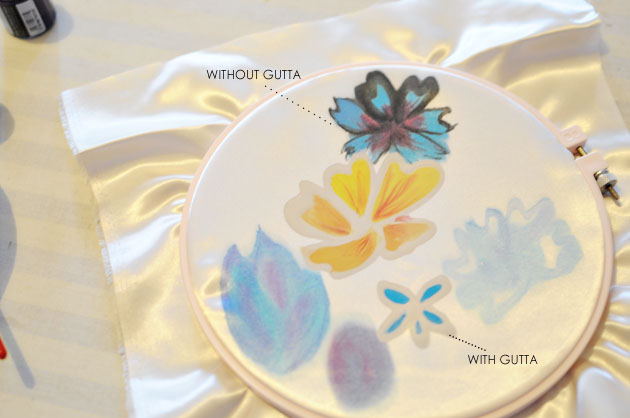 Above, you can see the motifs drawn using gutta and without gutta. I personally like it without gutta as the lines drawn with gutta look distracting. But at the same time, it might be hard to have bright colors without gutta. What do you all think?
Above, you can see the motifs drawn using gutta and without gutta. I personally like it without gutta as the lines drawn with gutta look distracting. But at the same time, it might be hard to have bright colors without gutta. What do you all think? 
{find me elsewhere: shop, facebook, etsy, twitter, pinterest}
My name is Chie. I design and make custom wedding dresses in Tokyo, Japan. Read More…
Get monthly updates including new items in the shop, favorite links and more!